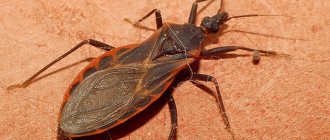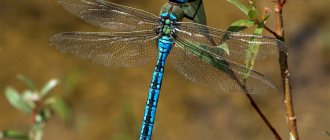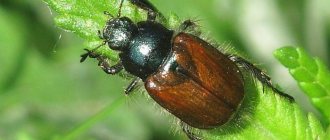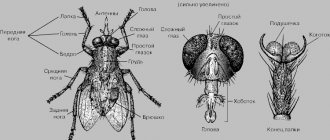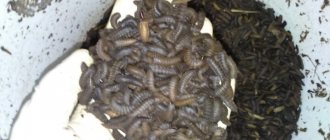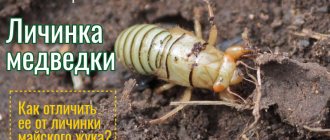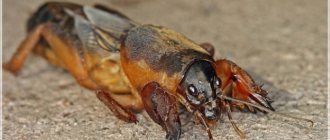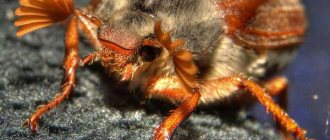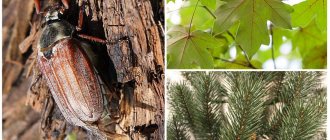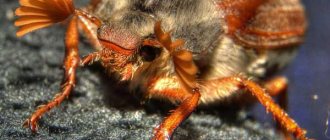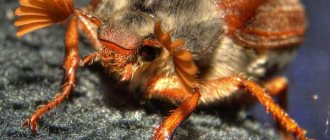Complete and incomplete transformation
In some insects, a larva hatches from an egg, which in general terms resembles an adult, an imago.
These are individuals with incomplete transformation. Their larvae are immediately capable of independent feeding, growth and molting, after the last of which they turn into adult insects. For example, incomplete transformation is typical for cockroaches. During their development, they go through the following stages: egg, larva, adult. Various types of beetles, butterflies, bees, bumblebees, ants and mosquitoes develop with complete metamorphosis. Their larvae are largely visually different from adults. This primarily lies in the absence of wings and compound eyes. In addition, the larvae have shortened or absent limbs, and their mouthparts are modified. After this stage, pupation occurs in insects with complete metamorphosis.
This process is very important. At the pupal stage, insects do not feed and practically do not move, which ensures survival of unfavorable conditions
The duration of this period varies from 6 days to several months depending on the species. In the photo you can see the larvae of the Colorado potato beetle, which, you see, barely resemble an adult.
Why do caterpillars grow so fast?
An important part of the survival strategy is rapid growth because at this stage of their life cycle many species are extremely vulnerable to predators, so short pupation times give them the best chance of survival. However, there are species that remain caterpillars for long periods of time, some overwintering and sometimes remaining in a tree trunk for several years.
Types of insect development
In all representatives of this class, the newborn individual differs significantly from adults. This type of development is called indirect. But in different groups of insects it can occur with complete or incomplete transformation. Often the larva and the adult differ not only in appearance, but also in their methods of life. Thus, the butterfly larva feeds on green foliage, and the adult on flower nectar. Insects, which are characterized by incomplete metamorphosis, lead the same lifestyle at all stages of development.
The term transformation itself means the presence of a larval stage in the process of individual development. Only insect ontogenesis can occur in different ways.
Habitat
The limited mobility of caterpillars does not facilitate their movement over long distances. In most cases, insects lead a terrestrial lifestyle, but there are also species that live in water.
All caterpillars are divided into two main groups: hidden and leading a free lifestyle. The former practically do not appear on the surface and live in the bark or in the ground away from sunlight. The latter are found on plants and are active during the daytime.
In nature, many insects and animals feed on caterpillars. This is due to their high protein content. Therefore, the color of insects living on plants has a camouflage color, which allows them to blend in with the surface of the leaves. Poisonous butterfly larvae are characterized by a frightening bright body shade.
Among those who eat caterpillars:
- wasps;
- spiders;
- birds;
- reptiles.
To protect themselves from attacks from predators, some butterfly larvae are capable of producing a whistle and protruding from their body a fork-shaped gland of a red-orange hue, which secretes mucus with a pungent odor.
Clothes moth larvae
Caterpillars of this species are practically no different in appearance from the larvae of food insects, however, unlike the latter, they cannot be found in the kitchen, among food items. Their diet consists only of what contains a special protein - keratin, which is found in derivatives of the epidermis: fluff, feathers, wool, hair.
At home, a moth nest can most often be found on the following things:
- fur coats,
- wool sweaters,
- down jackets,
- carpets,
- furniture upholstery,
- edges made of natural fur,
- felt products.
Depending on the location of the caterpillars, clothes moths are divided into several subspecies: fur moth, furniture moth or wool moth. Like the larvae of food moths, they form their home from available materials: fluff, hairs, wool. It is very difficult to notice a caterpillar hidden in such a cocoon. However, this can be done thanks to the following characteristic features:
- oblong-shaped cocoons-pellets are visible on the things,
- there are tunnels on the carpets and upholstery,
- holes appear in clothes,
- Bald spots are visible on fur products.
The larvae can even damage shoes if they are made of fur or felt. Felt insoles and felt boots are most often attacked by the pest.
Clothes moths, like food moths, have a fairly wide distribution area. Under natural conditions, the larvae feed on bird feathers in nests, as well as fallen animal hair in burrows or rookeries.
Winter items must be put away for storage by first wrapping them in a piece of fabric soaked in a special preparation, the smell of which repels pests, or placing them in a tarpaulin cover. During the hot season, you should periodically sort through your clothes, otherwise it will not be possible to avoid damage.
Interesting facts about caterpillars
- Most often, caterpillars feed on plant foods, leaves, flowers and fruits. However, there are other species, caterpillars, that prefer a diet of wax, wool or horny substances.
- In nature, there are also predator caterpillars that feed on other insects, aphids, ant larvae and pupae.
- The caterpillar eats the shell of its egg immediately after hatching, and then any other eggs it comes across.
- On average, a caterpillar has about 4,000 muscles in its body, which is about 7 times more than in the human body.
- Caterpillars, like spiders, can secrete silk thread. From it they weave a cocoon for themselves (interesting facts about spiders).
- After pupating, the silkworm caterpillar weaves a cocoon, the shell of which consists of a continuous silk thread up to 1500 meters long in the largest cocoons. It is these cocoons that are collected to obtain natural silk.
- The caterpillars of many butterflies living in northern latitudes do not have time to turn into a pupa in one summer, which is why they are forced to hibernate until the next summer.
- In Canada and Greenland, there are caterpillars that live up to 14 years before turning into a butterfly, since they do not have time to develop during the short summer, and they have to hibernate for the winter. At the same time, they can withstand temperatures down to -70 degrees.
- Caterpillars of some species live in anthills, being in a symbiotic relationship with ants. They impersonate the queen ant by secreting a special enzyme or making sounds with a sonic cilium. Ants feed and protect such a caterpillar
- Some caterpillars become toxic from the plants they eat. Therefore, birds do not eat them, knowing that they are poisonous.
- Immediately after hatching from the egg, the caterpillar begins to actively gain weight, eating everything suitable for it to eat, and within a few days its mass increases tens of times.
- Peru is home to unique caterpillars whose habits resemble hermit crabs. They find suitable objects, such as a dry leaf rolled into a tube, and use them as a shell for their protection.
- The dimensions of the smallest caterpillars do not exceed 2 mm, and the largest ones reach 12 cm.
- As the caterpillars grow, they molt several times, shedding the old, cramped shell and growing a new one.
- Caterpillars have 6 eyes, and in most species, five of them are located in a row, and the sixth grows above them, in the center.
- All caterpillars have a head consisting of six segments fused together.
- On the underside of the head is the foramen magnum, which in most cases has the shape of a heart symbol.
- All types of caterpillars go through a pupation stage before turning into a butterfly.
- Most caterpillars live much longer than the butterfly they later become.
- The muscles of caterpillars, unlike those of humans, serve as a skeleton for their body. They look like small balls of air through which blood circulates through the intertwining muscles.
Spider cocoons
For eggs
The spider's web was intended primarily for protection. Most types of cocoons have two layers: the inner layer is softer, the outer layer is stronger. The cocoon contains from 2 to 1000 eggs depending on the species. The fewer eggs in the cocoon, the more cocoons each spider creates.
For the victims
When approaching a victim caught in a web, spiders behave differently. Some bite the victim, paralyzing it, others quickly wrap the victim in a tight cocoon so that it cannot move. This is done due to the fact that sometimes the spider is much inferior in size and strength to its victim. He comes later, when the victim weakens or stops resisting.
For posterity
It’s amazing and touching how wandering spiders show care for their offspring. Many, obviously, had to see female wolf spiders running away from under their feet at the beginning of summer, with a soft round lump firmly attached to their abdomen. Not everyone knows that this is a cocoon containing many (several dozen) spider eggs. For many weeks, the spider carries a cocoon with her. The rate of development of embryos depends on the temperature of the external environment (air). With an increase in temperature of 10 degrees, the rate of egg incubation approximately doubles. Therefore, the spider, which usually prefers damp, shaded places, during the period of gestation of the cocoon, looks for open areas that are most warmed by the sun. By evening, due to the evaporation of water from the body, the weight of the already miniature animal is reduced by almost half! But only after sunset the female leaves the solarium, satisfying her thirst and gaining normal weight mainly due to dew. And the next morning, back in the sunshine, weather permitting. And the spider subjects itself to such voluntary torture for 2, 3 weeks.
Beneficial insects of the garden and vegetable garden
04/28/2016 One of the biological methods of natural plant protection in the garden involves the use of beneficial insects as natural enemies of harmful organisms, their study and assistance in spreading throughout the garden and living in it.
Beneficial insects
Ladybug
The ladybug is a well-known beneficial insect in the garden. It belongs to the round beetles and, depending on the species, is 4-9 mm long. The most common species is the seven-spotted ladybird. The beetle got its name for the 7 black dots on its red wing covers. But there are also beetles with yellow elytra and black dots, or dark beetles with light spots or without them at all. Also, the number of spots or the pattern of the wings can be varied. In total, we are home to about 70 species of large beetles, of which about 50 species feed on leaf aphids, and the rest feed on oribatid aphids and spider mites. Ladybugs, along with other leaf aphid killers, are essential helpers in the garden.
Adult ladybugs overwinter in open ground, for example, under leaves or dry grass. In the spring, ladybugs lay 10-20 eggs in a vertical group on branches or on the inside of a leaf near aphid colonies. Larvae from eggs go through 4 stages. They are usually painted dark gray with a yellow or red pattern. At the end of the larval stage, ladybugs begin to pupate and, as a rule, acquire a yellow color. After emerging from the pupa, the beetle needs another 2-3 days before it acquires its final color. It is especially important that both the larvae and the beetles themselves belong to the species of predatory insects and feed on aphids. The well-known seven-spotted ladybug destroys up to 150 aphids per day, smaller species - up to 60. While still larvae, the insects devour a total of up to 800 aphids. Thus, a female beetle destroys about 4 thousand adult aphids in her life.
When using ladybug as plant protection, its development cycles should be taken into account.
Stetorus, or tick ladybird
Active spider mite killer. This is a very small, mobile, like mercury, beetle with shiny black elytra, a rounded body shape and a very small size for a beetle - 1-1.5 mm. The larva is small, gray, very mobile. Both beetles and larvae actively feed on mites and their eggs, destroying from 800 to 2000 pests during their lives.
Beetles can be found in places where spider mites accumulate, most often on raspberries, on the back of the leaves. There have been cases when, even under production conditions, when raspberries were heavily infested with spider mites, the predator completely exterminated the pest within a few days, and there was no need for chemical treatment. In the garden plot, conditions for stetorus are more favorable, and if, when you detect spider mites, you notice tiny black bugs on the back of the leaves, you don’t have to worry: it will do its job - cleanse the plants of spider mites quickly and effectively.
By the way, both ladybugs and stetorus can be collected somewhere else and released in your garden; they take root well.
Osmia
These are fluffy solitary bees - and completely harmless. They bring enormous benefits to the garden. They fly out to collect nectar at air temperatures at which an ordinary domestic bee does not even show its nose from the hive. If you do not have buildings with a thatched roof on your site, we recommend making houses for the osmium. Not only swamp plants, but also banal pieces of wood with drilled holes are suitable as houses. You can also use elderberry branches; inside they have a soft core that must be removed, leaving a hollow tube - a house for osmium.
Osmium settles in the most unexpected places - in a hole from an old nail, in cracks. If a house is installed, the osmia will take root, and you will have apples, the garden will be pollinated perfectly.
Bees
Bees are true friends of the garden, as they bring enormous benefits to it. They are the only reliable assistants to agronomists and gardeners. It is known that the overwhelming majority of varieties of apple, pear, plum, cherry, raspberry, and gooseberry are self-sterile, that is, their ovaries cannot be fertilized with their own pollen. Thus, bees in the garden bring great benefit to humans because, while collecting pollen from flowers, they simultaneously cross-pollinate plants.
bumblebees
Bumblebees are one of the most cold-resistant insects, well adapted to life in the harsh conditions of the north, where other pollinators either cannot live or fly for a short time.
Thanks to their long proboscis, they can extract nectar even from flowers with narrow corollas, thereby collecting pollen from plants inaccessible to other insects.
Bumblebees collect not only nectar, but also pollen from plants. Bumblebees are helped to bring this delicacy to the nest by special devices located on their hind legs. But pollen ends up not only in special recesses on the paws. Sometimes dust particles linger on the abdomen and are then transferred to another flower.
Bumblebees can collect pollen and nectar from plants very, very quickly. Biologists have calculated that just one field bumblebee visits 2,634 flowers during a flight lasting 100 minutes. Therefore, bumblebees are rightfully considered the best pollinators of this valuable food plant.
Gallica
Various species of the gall midge family are better known to amateur gardeners as harmful insects (the larvae of some species develop in plant tissues, causing the formation of galls) than as helping in the fight against pests. The body length of gall midges varies from 1 to 5 mm. Well-known pests in the garden include, for example, the pear gall midge.
Beneficial gall midges feed on the larval stage of aphids. The most important species is Aphidoletes aphidimyza. The female (about 2-3 mm in size) lays 50-60 eggs in one life span of 1 week near the aphid colony. On the 4th-7th day, orange-red larvae hatch. The latter bite the aphids by the legs and inject a paralyzing liquid. The bitten aphid dies and is used by the larva for food. After 2 weeks, the fully formed larva falls to the ground and turns into a cocoon on the ground. After 3 weeks, the second brood hatches, whose larvae spend the winter in a cocoon on the ground and hatch in the spring as adults.
Ground beetle
From early spring to late autumn, quickly escaping beetles are found in gardens - these are predatory ground beetles that destroy eggs, larvae (caterpillars), pupae and adults of many harmful insects. One ground beetle per day can destroy three to five gooseberry moth caterpillars, up to ten sawfly caterpillars, and up to a hundred gall midge larvae.
They hunt at night, so they are rarely seen during the day. Beetles overwinter in the soil.
Ground beetle larvae
Ground beetle larvae feed on eggs of vegetable flies, small insects and their larvae, worms, and slugs. These beetles are rarely seen in the garden during the day; they hide in shelters. The length of the ground beetle is up to 4 cm, it is very mobile. Many species cannot fly and are therefore active at night. The color of the ground beetle is very diverse: large black and completely yellow flickering species are known. Adult insects overwinter in the garden in secluded, protected corners, for example, under a house or a woodpile.
Large ground beetles lay 40-60 eggs separately in shallow holes in the ground. The eggs hatch into larvae after a few days and hatch, depending on the species, 2-3 years later to become a pupa. After a pupal period of approximately 2-3 weeks, they hatch into adult (developed) ground beetles. Along with ground beetles, which live mainly on the ground, there are also arboreal and flying species. They feed on small insects and worms and therefore live in rotting organic matter, such as compost.
Ground beetles should be provided with shelter (foliage, sawdust and shavings, small piles of stones); they live in open ground, sometimes hiding in earthen crevices.
Pesticides are the worst enemy of ground beetles!
Hoverflies
Hoverflies are important in horticulture because their larvae feed on aphids. Larvae develop in different conditions - in soil, slurry or on plants. Visually, the hoverfly is similar to a wasp; the length of an adult is 8-15 mm. The peculiarity of hoverflies, reflected in their name, is that in flight they can seem to hover in place, while making a sound vaguely reminiscent of the murmur of water.
Egg laying occurs in aphid colonies. The eggs are 1 mm in size, oblong, white. The larvae that hatch from the eggs have no legs and move like snails. They are colored white or yellow and look like fly larvae.
To hunt for aphids, hoverflies use their hook-shaped jaws, with which they firmly hold the prey, sucking it out. The development of the larva to the pupal stage lasts 2 weeks. During this time, the larva eats up to 700 aphids. Hoverfly larvae are active mainly at night and go hunting no earlier than dusk. The hoverfly experiences the pupal stage in a shell in the form of a droplet, located near the aphid colony on the leaves or on the ground. Some species breed several generations, most – up to 5 per year. In some species, females overwinter in the same way as larvae or pupae. The hoverflies themselves feed on flower and honeydew, as well as the secretions of aphids.
Areas with flowering plants are most suitable for hoverflies, but not well-groomed lawns. Hoverflies especially love plants that bloom with yellow flowers.
To overwinter hoverflies, you can leave small wooden boxes filled with dry grass or shavings.
Spiders
Everyone knows these insects with a rounded abdomen and a fused cephalothorax. However, not everyone knows about their role in nature. Most of them are predators. Spiders are found in the soil, under fallen leaves, on herbaceous plants and trees. Often the webs woven by spiders are confused with the webs left by the common spider mite.
Trichogramma
Trichogramma is an effective means of protecting plants from harmful insects, both in open and closed ground. This is a small insect (size - 0.4-0.9 mm; color - from yellow to black), which is exclusively a parasite of insect eggs. However, only Trichogramma larvae lead a parasitic lifestyle, feeding on the contents of insect eggs, while adult Trichogramma individuals in nature feed on flower nectar and dew.
Trichogramma females, 2-3 hours after birth and mating, begin to search for butterfly eggs, and having found them, pierce them with the ovipositor and lay their eggs in them. Depending on the size of the host egg, it can develop from 1 to 60 egg eaters. The duration of development depends, first of all, on temperature conditions and lasts from 8 days at 30ºС, 11 – at 25ºС, to 53 days at 11ºС. The lifespan of an adult entomophage depends on temperature, humidity and carbohydrate nutrition (2-5 days without food, up to 7-15 days with feeding).
Trichogramma parasitizes the eggs of more than 60 species of harmful butterflies: cutworms (gnawing and leaf-gnawing); whites (cabbage, turnip, rapeseed); moths (corn stalk and meadow borers); leaf roller; codling moth, etc.
Lacewing and its larvae
The lacewing, along with ladybugs, is an enemy of aphids. In our gardens the most common species is green with yellow eyes. The beetle got its name precisely because of these eyes. An adult has a wingspan of up to 3 cm. Green, oblong insects wear house-shaped, transparent, veined wings, folding them on the lower part of their long body.
The female lays about 20 greenish eggs, individually or in groups, on the bark or leaves. The larvae hatching from the eggs develop within 2-3 weeks, depending on weather conditions. Their length is only 7 mm, their jaws are long, sickle-shaped and pointed. The larvae feed on small insects, especially aphids. Individual individuals are capable of destroying up to 500 aphids during development.
After 18 days, the larvae hide in a protected place, wrap themselves and turn into a white round cocoon. After the lacewing emerges from the cocoon, the next generation begins. In total, 2 generations can appear per year. Adults feed, as a rule, on honeydew and pollen, and on occasion do not disdain small insects. The adult lacewing overwinters in secluded corners, so sometimes it can be found in residential areas. During the wintering period, the insect may acquire a yellow or brown color, but in the spring it turns green again.
Ebony Lion
Along with the common lacewing, we also have about 42 species of aphid lions, which, like the lacewing, belong to the true reticuloptera. One of the most famous species has a wingspan (brown with a specific shape) of about 3 cm. Adults and larvae feed on aphids and contribute to the biological balance in the fight against this pest.
The use for targeted biological protection of plants in greenhouses and on protected ground has been tested and given good results. To do this, it is necessary to place 20 lacewing eggs on each square meter of surface, which can be purchased in special biological laboratories.
Riders
Ichneumas develop as parasites on various hosts, which can be many insects, with the exception of spiders. For gardeners, parasites are of great importance, as they destroy butterfly caterpillars, fly larvae and aphids. In appearance, the riders resemble wasps and in most cases have a dark or variegated color. Their size varies and ranges from less than 1 mm to more than 10 mm. As an example, mention should be made of 2 different types of equestrian that have special significance. The first species parasitizes on the caterpillars of the cabbage butterfly, the second on aphids. The rider lays eggs on an insect, its larva, caterpillar, or in their bodies with the help of a special sting that pierces the body of the victim with lightning speed. The larva of the corresponding species of ichneumon hatches from the egg and sucks out the “host”.
Ichondritus can overwinter as a larva, pupa or adult. At one time, the female lays about 30 eggs in the cabbage caterpillar. In total, she can lay up to 200 eggs. After the larvae hatch in the caterpillar, the shell of its body cracks, releasing the larvae, which a little later turn into pupae.
Species that parasitize aphids lay eggs in the body of the aphid. The larva emerging from the egg sucks the aphid from the inside, thus feeding, and pupates in a cocoon of fine web. After pupation, the parasite emerges from the cocoon through a small hole in the aphid's shell. Each female affects about 200 aphids. The development of an insect, from egg to pupal stage, lasts about 10 days, so several generations may appear within a year. Aphids affected by parasites have a characteristic copper color and a cylindrical body.
The equestrian likes to settle in umbelliferous plants (dill, coriander, cumin, marigold, etc.).
Common earwig
The common earwig, belonging to the order Leatherwing, is well known to gardeners and gardeners. The body length is 3.5-5 mm, the front wings are solid, the hind wings are membranous. There are also wingless forms. Its claws located in the back of the body are impressive. The earwig hunts mainly at dusk and at night, and during the day it hides in dark narrow crevices.
By destroying harmful insects such as dahlia woodlice, the earwig can damage tender young dahlia plants.
In spring and autumn, the female lays up to 100 eggs in a hole, which she digs herself, guards them and takes care of her offspring - first about the eggs, and later about the larvae. Earwigs overwinter in shelters - in the bark of trees, cracks in buildings, in soil, in flower pots filled with small shavings or some other material, such as moss.
Flower pots filled with wood shavings, moss or hay can be used as shelters. Such pots are placed between vegetable crops or hung on trees.
Pots should be cleaned out in the winter and refilled in the spring.
Digging around tree trunks promotes the normal functioning of the insect. Earwigs often also seek refuge for the winter under trees, in their fallen leaves.
Bedbugs
The predatory bug belongs to the class of weevils. Its different species have specific food sources. For some it is the juice of some plant, for others it is insects. The gardener is interested, first of all, in the latter, which, among other things, destroy aphids. These include soft-bodied and false bugs, among which some species feed primarily on spider mites.
Flower bugs are small predatory insects 3-4 mm long. At one time, the female lays up to 8 eggs, mainly along the edges of the leaves. During the year, bedbugs hatch 2 generations, and in areas with a warm climate even 3. Predatory bugs overwinter as adults. Larger species of the flower bug also feed on gall midge larvae.
How to attract insects to the garden?
If we take a lot of beneficial insects from somewhere and release them into the garden, the effect will only be short-term. It is much more important that beneficial insects take root in the garden. To do this, we need to create suitable conditions for them. First of all, it is a food supply and places for sheltering and breeding of beneficial insects.
To reproduce and increase the species composition of beneficial insects, including predatory insects (entomophages), it is important to take into account their characteristics:
— predatory insects are attracted to flowering plants, not pests (phytophages); - predatory insects are used for reproduction and destroy the type of “host”, i.e., the pest on which they themselves developed.
So, beneficial insects are attracted to the garden by flowering plants (flowering weeds), not pests.
The presence of natural nectar flowers in the garden and lawns, even in small quantities, allows predatory insects to provide additional nutrition during the reproduction stages. Moreover, some predatory insects are able to reproduce effectively only by combining feeding on nectar or honeydew and insect prey. Therefore, the presence of flowering weeds, even in fields where crops are grown, at a level below the economic threshold of harmfulness, increases the effectiveness of predatory insects and is considered appropriate.
There must always be a number of different pests in the garden in order for beneficial insects to survive.
Specialized predatory insects look for their “master”, i.e., a pest no matter how large it is. Therefore, once again, there should always be a certain number of different pests in the garden, no matter how paradoxical it may sound! Typically, plants are planted in the hedges around the garden on which pests develop and predatory insects survive. Only in this case can they prevent pest outbreaks. Polyphagous predatory insects show interest in a particular type of pest only when its numbers are high, so they are usually late.
Therefore, a diversity of predatory insect species is necessary for sustainable pest control. And to expand the species composition and reproduction of predatory insects, their nectar-bearing food plants should be sown. These are typically asteraceous umbelliferous and paniculate plants, whose many small flowers provide multiple sources of nectar and together form a habitat for beneficial insects, including bees, and butterflies.
Plants that Attract Beneficial Insects
Tansy
It attracts ladybugs, cunning bugs, small parasitic wasps, lacewings and flies primarily due to its feeding value. The tansy aphid, for example, feeds on the sap of the plant and often accumulates in large numbers along the edges of its serrated leaves.
The advantage of tansy is that an infusion of tansy leaves repels the Colorado potato beetle. I’ll add on my own that abundant tansy herbage is good for use in composts. This compost does not harbor mole cricket and chafer larvae.
Decoctions of tansy leaves and flowers contain many different vitamins and essential substances, improve the taste of kvass and dough, and jam is made from the flowers.
Chamomile
A perennial plant attractive to wasps and flies. During the flowering period it is covered with many yellow flowers.
Lemon marigolds
Attract small wasps and spiders. Seedlings are planted in the ground when the danger of frost has passed.
Caraway
Attracts sly bugs, spiders, small wasps, hoverflies and lacewings during the flowering period. Its aromatic seeds are used in baking and for making marinades.
Dill fragrant
Attracts ladybugs, hoverflies, small wasps and spiders.
Buckwheat
It is an effective soil-forming plant that increases the content of organic matter when plowed.
Honey plant
Attracts not only pollinating bees, but also flies, ladybugs, hoverflies, and predatory bugs.
Spearmint
Used to make refreshing tea and as a fragrance. Mint is attractive to flies and spiders.
Many types of legumes have the ability to attract beneficial insects, for example: crimson clover, creeping clover, vetch. They provide beneficial insects with constant food and moisture and enrich the soil with nitrogen.
To ensure the availability of flowering plants throughout the season that are attractive to beneficial insects, you need to start with those that bloom earlier, for example, with buckwheat, which will be replaced by fragrant dill. You should immediately plant marigolds and calendula so that they bloom in mid-summer. You should grow tansy, sweet clover and navel, which bloom for a long time from year to year.
The goal of using beneficial insects is not to completely destroy pests, but to control their numbers.
By creating conditions that combine a favorable environment for beneficial insects and decorativeness, a natural balance can be achieved between the number of harmful and beneficial insects.
Share on social networks:
Methods of pest control
There are many ways insect larvae can appear in your home. A butterfly can enter your home through an open door or window, or fly through a ventilation hole. In addition, larvae may be present in brought items or furniture. The insect can easily be brought into the apartment in the folds of clothing, where the butterfly climbed while you were visiting public places (cafes, theaters, etc.).
After this, the unnoticed pest finds a place suitable for the development of its offspring and lays larvae. Therefore, at the first sign of the appearance of an insect, it is necessary to urgently take measures to destroy it:
- You can destroy larvae on items that are subject to heat treatment by washing in hot water or steaming.
- House moths do not tolerate exposure to ultraviolet rays, which cause protein coagulation in the pest’s body. Therefore, in order to get rid of the pest and larvae, it is necessary to irradiate clothes with a quartz lamp or take things outside. The duration of such processing should be at least an hour.
- Exposure to low temperatures also allows you to get rid of eggs and larvae of house moths. Freezing should be carried out within 24 hours.
- Chemical preparations specially developed for this purpose, which are produced mainly in the form of a spray, will also help to destroy the pest. The product treats contaminated items, as well as their storage areas. This method is especially effective in the fight against carpet moths.
- In addition to sprays, preparations to combat house moths are available in the form of plates, gels, aerosols and tablets. Particularly popular are products such as Moskitol, Reid anti-moth, Dezmol, anti-moth sections, Supromit, etc.
It should be understood that all chemicals used to combat house moths are very toxic. Therefore, when using them, it is necessary to take certain safety measures: provide yourself with personal protective equipment and strictly follow the instructions.
How to remove parasites?
Removing a gadfly larva is an unpleasant and complicated procedure. It is advisable that it be carried out by a doctor - a surgeon or an ophthalmologist if parasites suddenly get into the eye (which also happens, although rarely).
If for some reason you cannot get medical help, then you should try to remove them from the body yourself as quickly as possible. Moreover, it is best to ask relatives or friends - especially if the parasites are located on the back, head or other hard-to-reach place.
The procedure for removing gadfly larvae itself will be most effective if you follow the action plan below:
- The first step is to take a thick, sticky product. Scotch tape, Vaseline, PVA glue will do. You need to apply it to the nodule. And quite abundantly, because it is important to ensure that oxygen does not enter the resulting fistula. If necessary, you can open the abscess with a scalpel.
- Now we wait. The larva, deprived of air, will partially crawl out. Then you should carefully remove it from the body. It is best to use tweezers or cosmetic tongs. It is important not to crush or tear the parasite. Otherwise, part of it will remain inside, and to remove it you will have to cut the skin deeply.
- As soon as the “baby” gadfly is successfully removed, it is necessary to disinfect the wound. It would be a good idea to bandage it with a sterile cloth.
- After which it is recommended to consult a doctor - a parasitologist or infectious disease specialist - as soon as possible. He will see if you managed to completely remove the parasites from under the skin, and will also prescribe the necessary medications (including antibiotics) and anti-inflammatory ointments.
By the way, in medicine, surgical removal is not always used to combat the larvae of the subcutaneous gadfly. This method is good when the location of the parasites is clearly visible. If they are hidden deep under the skin, then doctors or veterinarians prescribe special ointments and creams that drive the gadfly larvae out. In some cases, drug therapy is also carried out. A special course of medications helps drive out the vile parasites, creating an unfavorable environment for them in the body. But just don’t start treatment with medications without consulting a specialist!
For reference! The gadfly rarely manages to lay a larva in a person. Most often, parasites enter the body of animals.
Types of true larvae
True larvae differ significantly from adults in their appearance, the absence of compound eyes and external wing rudiments, as well as the uniformity of body segments, without a clear division into the thorax and abdomen. Larvae of this type are characteristic only of insects with complete metamorphosis[1].
The following types of true larvae are distinguished.
- Campodeoid - mobile larvae, usually dark-colored, with dense integument and three pairs of thoracic legs, are also distinguished by a well-separated progratic head: ground beetles, diving beetles, etc., reticulates, some caddisflies.
- Vermiformes are usually sedentary, sometimes light-colored larvae, lacking abdominal and thoracic legs (diptera, many hymenoptera: ichneumonriders, bees, wasps, ants and others, weevils and some other beetles) or have three pairs of short thoracic legs (many beetles).
- Caterpillar or erucoid - moderately mobile larvae with three pairs of thoracic legs and 2–8 pairs of short abdominal legs: scorpion larvae, butterfly caterpillars, pseudo-caterpillars.
Structure
Most have cylindrical bodies composed of several segments, with three pairs of true legs on the thorax and several pairs of short, thicker false limbs on the abdomen. The head contains six pairs of small eyes (stem eyes) that function in detecting light but not in forming images. They have short, segmented antennae and strong jaws. Many caterpillars in the order Lepidoptera are called worms, such as the silkworm (silkworm) and the army worm (Spodoptera frugipeda).
You may be interested in:Swedish Lake Mälaren: location and main attractions
Insect cocoons
Sawfly larva Cimbex sp. (Hymenoptera: Symphyta) constructs a cocoon, attached on one side to a transparent wall, which allows you to see its work inside the cocoon. The larva has not yet entered the pronymphal state and is therefore mobile. By manipulating the head, she places new layers of silk thread on the inner surface of the cocoon under construction, which is produced by the Malpighian vessels and released from the opening in the area of the oral appendages
The larvae of some insects with complete metamorphosis (many butterflies, caddisflies, hymenoptera, lacewings, etc.) before molting onto the pupa weave a cocoon of silk, which is either produced by the labial glands and secreted from the mouth (more precisely, from a special opening between the lower lip and the hypopharynx), or produced by the Malpighian vessels and secreted from the anus. Cocoons can be soft or hard, dense or loose, of various colors, and consist of different layers, depending on the type of larva that created them. Some larvae embed soil particles, their excrement and/or bristles shed from their bodies into the silk cocoon. Often cocoons are located in the soil or in other hard-to-reach places - under leaves, in cracks in the bark of trees, etc. Inside the cocoon, the larva enters the pronymph state and then molts, and thus the sedentary or completely motionless pronymph and pupa are protected by the cocoon. In some insects, the pupa leaves the cocoon just before molting into an adult insect; the pupae of some insects (caddisflies, scorpionflies, lacewings) gnaw the cocoon with their well-developed mandibles; in the pupae of other insects, the mandibles are motionless or absent. The pupae of beetles and hymenoptera molt onto the adult insect right inside the cocoon. In the latter case, the adult insect manages to spread its wings, soft after molting, in the cramped space of the cocoon and wait for them to harden, after which it folds its wings and gnaws its way out of the cocoon. The females of some bagworms do not leave the cocoon[1].
- The caterpillar secures the cocoon.
- Cocoon and pupa of the Actias luna butterfly.
- Cocoons of the butterfly Actias luna.
- An Actias luna butterfly leaves a cocoon.
Notes
| larva in Wiktionary |
- ↑ 1 2 3 Bey-Bienko G. Ya. General entomology. - stereotypical. - M.: Prospekt Nauki, 2008. - 486 p. — ISBN 978-5-903090-13-6.
- ↑ 1 2 Animal life. Arthropods: trilobites, chelicerates, trachea-breathers. Onychophora / ed. Gilyarova M. S., Pravdina F. N. - 2nd, revised. - M.: Education, 1984. - T. 3. - 463 p.
- ↑ Biological encyclopedic dictionary / ch. ed. M. S. Gilyarov, editor: A. A. Babaev, G. G. Vinberg, G. A. Zavarzin and others. - 2nd ed. - M.: Sov. Encyclopedia, 1986.
| Stages of insect development | |
| with incomplete transformation | egg → larva (nymph) → adult |
| with complete transformation | egg → larva (caterpillar, coret, rat, false caterpillar, bloodworm, maggot, wireworm) → pupa (puparium) → adult |
| with hypermetamorphosis | egg → triungulin → larva → pupa → |
This page was last edited on April 5, 2019 at 07:15.
Dream Interpretation, Insects
That which flies, buzzes, stings, rummages, bites, distracts and is generally perceived as trivial, insignificant, annoying, capable of causing only minor troubles and, nevertheless, creating quite sensitive interference. In general, insects are not strong (not deep), but repeated or obsessive sensations, thoughts, feelings that can lead to disharmony, deprive of peace and confidence. The appearance of insects in a dream can indicate troubles in the future, illnesses and minor mental disharmonies. Often individual insects (ant, butterfly, bee...) act exclusively in a creative role (for example, lice or fleas for receiving money, and a butterfly for meeting a loved one).
Prevention
Before concluding our review, as a prelude to it, I would like to recall the basic rules for preventing the appearance of these unpleasant guests in our home.
In order not to attract flies and prevent them from breeding in the apartment, you must follow these rules, namely:
- keep the house clean;
- remove fruits and vegetables, as well as meat products, from open areas in a timely manner;
- promptly send everything that has accumulated in the trash can to recycling containers;
- use mosquito nets on windows;
- follow traditional methods of insect control.
List of larvae with independent names
- The axolotl is a neotenic larva of Ambystoma (tailed amphibians).
- Actinotroch is a phoronid larva.
- Auricularia is the early phase of development of holothurian larvae.
- Bipinnaria is the early phase of sea star larval development.
- Brachiolaria is the late developmental stage of a starfish larva.
- Veliger is a larva of gastropods and bivalves.
- Glaucotoe is a crawling crustacean larva.
- Glochidium is a larva of bivalves.
- A tadpole is the larva of a tailless amphibian.
- The caterpillar is the larva of butterflies.
- Dipleurula (dipleurula) is an early larval form common to echinoderms and coelenterates, which later transforms in different groups into auricularia, bipinnaria, pluteus or tornaria.
- Doliolaria is the middle phase of development of holothurian larvae.
- Zoea is an early larva of a decapod crustacean.
- Coracidium is a larva of a wide tapeworm, covered with cilia and equipped with six hooks.
- The coretra is a mosquito larva from the family Chaoboridae.
- The rat is the larva of some hover flies (Diptera: Syrphidae).
- Leptocephalus is a larva (fry) of an eel and other eel-like fish.
- Lycophora is a cestode larva.
- The false caterpillar is the larva of sawflies (Hymenoptera-Symphyta).
- The false wireworm is a larva of beetles of the darkling beetle and pollen beetle families.
- Megalopa is a late larva of decapod crustaceans.
- Metanauplius is the larval stage of many crustacean species, following the nauplius.
- Metatrochophore is a larva of polychaete annelids that develops from a trochophore and turns into a nectochaete.
- Mysis is a late larva of long-tailed decapod crustaceans (Decapoda-Macrura).
- Miracidium is a sporocyst larva of flukes (Trematoda).
- The bloodworm is the larva of bell mosquitoes (Diptera: Chironomidae).
- Müllerian larva is the larva of ciliated polyclada worms (Polyclada)
- Nauplius is the early phase of larval development, characteristic of many crustaceans.
- Naiad is the larva of dragonflies.
- Nektochaete is a late larva of polychaete annelids that develops from a metatrochophore.
- Nymph is the traditional name for the larval stage of development of some arthropods with incomplete metamorphosis (mites and a number of groups of insects).
- Oncomiracidium is the larva of monogenea (monogenetic flukes).
- Oncosphere, or six-hooked larva, is the larva of tapeworms (Cestoda).
- Maggot is the larva of round stitch flies.
- Parenchymula is the larva of sponges.
- The pentacle is the late developmental phase of holothurian larvae.
- Sandwort is a lamprey larva.
- Pilidium is a nemertean larva.
- Planktosphere is the larva of a gastrointestinal worm.
- Planula is a coelenterate larva.
- Pluteus, or pluteus, is the larva of an echinoderm. For the larvae of brittle stars and sea urchins, special terms are used: Ophiopluteus, or ophiopluteus - brittle star larva,
- Echinopluteus, or Echinopluteus, is the larva of sea urchins.
Who eats mosquitoes and mosquito larvae
These insects and their larvae are quite a tasty treat for some representatives of the fauna:
- For animals,
- For the birds,
- For insects,
- For fish.
Many amphibians feed on mosquitoes with great pleasure:
- frogs,
- Tritons,
- Toads,
- Salamanders.
They won’t refuse such a delicacy:
- dragonflies,
- Spiders,
- The bats,
- water bugs,
- Small birds,
- Some beetles
- water mites,
- Lizards,
- Chameleons.
At the same time, waterfowl feed not only on mosquitoes, but also on their larvae, which are also called bloodworms. And, of course, fish readily feed on blood-sucking larvae. In order to reduce the level of mosquito reproduction, amazing mosquito fish are bred in special nurseries, the diet of which is simply difficult to imagine without mosquito larvae. There is a very interesting fact: the larvae of other insects, for example, swimming beetles and dragonflies, feed on larvae.
They also feed on mosquito larvae:
- Jerzy,
- frogs,
- Water striders,
- crustaceans,
- Toads,
- Aquarium fish.
Are gadfly larvae dangerous for pets?
We have found out that humans and cattle can suffer from these parasites. What about our pets? Especially dogs and cats that periodically walk outside. There is a certain risk.
At the same time, infection of dogs and cats occurs not only through contact with intermediary insects. These animals like to lie on the ground or in the sand, where gadflies also often lay their eggs. It turns out that a dog or cat, having run around, lies down to rest, which makes it possible for the larvae to get onto the pet’s body. Also, the most likely places of infection are areas with high vegetation and areas with a fairly large population of rodents.
It is not difficult to notice symptoms of infestation with gadfly larvae in dogs or cats. As a rule, the animal begins to behave passively, coughing, and breathing heavily. He often experiences loss of coordination, fever, and even paralysis of the limbs. If at the same time there are tubercles and bumps on the pet’s skin with an obvious opening for the vital activity of the parasite, then, most likely, this is indeed an infestation by botfly larvae.
It is necessary to promptly seek help from a veterinarian. With a greater degree of probability, “aibolit” will prescribe antiparasitic medications that can neutralize insects and alleviate symptoms. If possible, he will also perform surgical removal of parasites from your pet’s body.
For reference! There is a known case where more than a hundred gadfly larvae were found under the skin of a dog. At the same time, the parasites managed to spread throughout the body. They were on the paws, back, stomach, lips and ears. Only timely medical assistance saved the four-legged animal’s life.
Cocoons of fictional creatures
- The alien from the movie "Arachnid" covered the victim with a cocoon, in which the larva fed on the semi-digested victim. The other cocoon was used by him for sleeping.
- Aliens often turn victims into cocoons and leave them next to their eggs.
- The cocoons contained vampires in the films Van Helsing (the stillborn offspring of Dracula) and The Shepherd (during transport by train).
- Cocoons are devices from the film of the same name and its sequel, in which the aliens were in a state of suspended animation.
- Mogwai, creatures from the films Gremlins and Gremlins 2: The New Batch, pupate before transforming into .
- Cocoon is an alien spaceship from the movie Earthling.
How to protect yourself from gadfly larvae?
Finally, we will discuss the most important thing - ways to protect yourself from these parasites. At the same time, we note that there are quite a lot of them. But you should start with prevention, which includes:
- avoiding places where gadflies live in large numbers;
- use of clothing that protects against bites of various insects;
- use of special repellents.
- treating body parts that have been bitten by blood-sucking insects with disinfectants.
It would be a good idea to exclude visiting potentially dangerous countries where you can find many gadflies. These are countries in Africa, South and North America.
Those involved in livestock farming should also take preventive measures. They will prevent the spread of gadflies and significantly reduce the number of cases of livestock infestation with their larvae.
- Regular examination of animals for the presence of fistulas and nodules that are typical when parasites enter the body. Particular attention should be paid to the back, croup and lower back.
- Treatment of the entire livestock with special preparations, the action of which is aimed at destroying the larvae. The most preferable time for this is late summer or early autumn.
- Grazing cattle in the morning (before 10:00) and in the evening (after 18:00), when the activity of the gadflies subsides. During the daytime, it is advisable to keep animals under shelters or indoors.
- Use of special traps for gadflies and repellers on pastures and farms.
Business and finance
BusinessBanksWealth and welfareCorruption (Crime)MarketingManagementInvestmentSecuritiesManagementOpen joint stock companiesProjectsDocumentsSecurities, controlSecurities, valuationsBondsDebtCurrencyReal estate (Rent)ProfessionsJobTradeServicesFinanceInsuranceBudgetFinancial servicesCreditsCompaniesState-owned enterprisesEconomyMacroeconomics icaMicroeconomicsTaxesAuditIndustryMetallurgyOilAgricultureEnergyConstructionArchitectureInteriorFloors and ceilingsConstruction processBuilding materialsThermal insulationExterior
reference Information
DocumentsLawsNotificationsDocument approvalsContractsRequests for proposalsTechnical specificationsDevelopment plansDocument managementAnalyticsEventsCompetitionsResultsCity administrationsOrdersContractsExecution of workProtocols for consideration of applicationsAuctionsProjectsProtocolsBudget organizationsMunicipalitiesDistrictsEducationsProgramsReports on mentionsDocumentary baseSecuritiesRegulationsFinancial documentsResolutionsRubricator by topicFinancecities of the Russian Federationregions by exact datesRegulationsTermsScientific terminologyFinancialEconomicTimeDates20152016Documents in the financial sector
Dream Interpretation, Big
A large and tall door, gate - portends wealth and nobility. A large river with clean and clear water is a harbinger of great happiness. A big fish fights, jumps - portends fame, glory. A large tree unexpectedly breaks down - portends trouble, misfortune. If you are going to cut down a large tree, it portends big profits and material well-being. Climbing a big tree means fame, fame, luck, happiness. A basin, a large bowl - portends an increase in reserves, great happiness. A large temple of ancestors means happiness and good luck in all matters. There is a coffin in the large hall - it portends joy and peace. Climbing a big tree means fame, fame, luck, happiness. You see large and wide city walls - great wealth and much joy. Driving along the highway and falling into a hole is a loss of wealth. Leaves falling from a large tree are a happy event in the house. Raking manure into a large pile means wealth, material well-being. A person gives you a big bucket - a benefit.
Lifespan
As we already understood from the previous chapters of our review, the total lifespan of a fly can be 10-30 days. Having summed up all the stages of the life cycle during which the development of a fly occurs from birth as an egg to the death of an adult winged individual, we arrive at exactly this general period.
What factors influence the lifespan of a buzzing parasite? First of all, the temperature regime of its habitat. The insect can live in conditions from 10 to 40 degrees, but the optimal range is 18-25 degrees.
The life of a fly can last much longer than several weeks, especially if the insect managed to survive the winter period. Some particularly lucky individuals can live for 2 months, but this is still largely an exception.
Dream Interpretation, Larva
If you have seen insect larvae, it means that soon you will learn something about an important person that will greatly surprise you, and you will want to tell others about the news. No need to do this
You should think again and again: do you really want this? Won't you ruin the life of both yourself and the person who has become the object of your random attention? . Larva!! If you saw insect larvae in a dream, it means that soon you will learn something about an important person that will greatly surprise you; you will want to tell others about the news. There is no need to do this. You should think again and again: do you really want this? Won't you ruin the life of both yourself and the person who became the object of your random attention?!! Mercenary!! If you dreamed that you were a mercenary, it means that in real life you will have to help a person who is not very attractive to you.
How to find them?
The skin beetle's offspring spend most of their lives in secluded crevices hidden from view, on the mezzanines of closets that have not been climbed into for a long time, in closed shoe boxes, in the folds of a bed, in chests of drawers that are rarely used.
It is possible to detect creatures only during general cleaning or after damage to fur and leather items. It is important to carefully inspect:
- cracks behind baseboards;
- places in floor coverings where crumbs and organic residues can get into;
- shelves, cabinets with wool and fur products;
- mezzanines and closets;
- pots with indoor plants;
- electric lamps;
- carpets;
- window frames and window sills;
- folds of upholstered furniture, sofas, beds.
You should not rejoice if you come across single individuals that you immediately destroyed. Somewhere in a hidden place there lives a large colony that is not so easy to detect. You are more likely to find adult beetles flying around your apartment looking for mating partners. If the “meeting” took place, it means that there are numerous offspring in your home, going through the molting stages and devouring everything that comes along the way. What to do and how to deal with this?
Mosquito breeding
There are four main development cycles in the life of these insects:
- An egg that matures in 2 to 8 days
- A blood-sucking larva that lives in water bodies and feeds on microorganisms found in it. The larvae breathe air using special breathing tubes. During their entire development, the larvae molt 4 times, and after that they turn into a pupa,
- Development of the pupa, which lasts up to 5 days. As the pupa grows, it changes color and becomes black.
- The imago stage, which implies an adult insect that already lives on land.
The males arrive first. They form a swarm and wait for females to mate. This type of reproduction is called “eurygamy”. It is worth noting that the bloodsuckers living in the city have learned to mate without forming a swarm. When the female is already fertilized, she goes for a portion of blood. After that, she lays eggs, and the cycle begins again.
Features of individual types
You may be interested in: Butterfly breeds: names, descriptions, photos
Some caterpillars have special respiratory structures that allow them to survive in aquatic habitats. For example, the larvae of some pyramidal clams (family Pyralidae) are aquatic, and several members of the genus Hyposmocoma (family Cosmopterigidae) have an amphibious caterpillar stage. Some caterpillars spin silken sheaths that provide protective coverings. They often have leaves, pebbles and more woven into them, making them look like part of their natural surroundings.
Wax moth
The droppings of wax moth larvae resemble small onion seeds in appearance. Individually, each specimen is a small worm of a reddish or light gray hue. Wax moth caterpillars live in honeycombs and feed on wax (hence the name). If cocoons are found in the hive, it is necessary to urgently take measures to destroy them, otherwise you risk being left without honey, or even without the entire bee family.
The caterpillar goes through several stages of development before becoming a pupa. The duration of the pupation period depends on the type of pest and external conditions. For example, the development of food moth caterpillars occurs much faster than that of clothes moths. This is due to the richest diet of the former. Food moth larvae only need 4–5 weeks to reach the pupation stage, while clothes moth caterpillars will need 2–3 months.
Pupation of caterpillars occurs in hard-to-reach and dark places, but there are certain types of pests that choose light areas for this. The pupae are covered with a kind of dark-colored shell, forming a cocoon, and in this form their further development occurs until they turn into a flying insect.
After 1–2 weeks, an inconspicuous gray butterfly will appear from a case suspended from the closet wall. Due to the absence of an oral apparatus, the life of the insect will be short - only 2-3 weeks. During this period, the butterfly manages to mate with the male, find a place for successful growth and development of the larvae, and lay eggs.
It is interesting that the insects fluttering around the house are mostly male. Female moths prefer to hide on the shelves of kitchen cabinets and in the folds of clothing. After fertilization, they rarely get out of their hiding places, so fighting moths by running around the apartment and clapping your hands makes no sense.
Natural enemies of caterpillars
Due to their small size and worm-like shape, the caterpillars are preyed upon by many species of animals, but the caterpillar's main enemies are birds and insects. Caterpillars are also often preyed on by small mammals and reptiles.
Caterpillars cannot easily escape from predators because they move slowly and do not yet have wings. This means they either have to rely on camouflage to keep predators from noticing them (which gives us caterpillars that look like leaves, plant stems, etc.) or they have evolved to be bright and sharp, so that's it. anyone who might want to eat them knows it would be a bad idea.
Caterpillars are found in almost all climates around the world, making their predators abundant.
In addition to birds, they feed on caterpillars:
- People - Caterpillars are a delicacy for people in parts of the world such as Botswana in southern Africa, as well as East Asian countries such as China. In fact, caterpillars flock to these areas daily due to their high nutritional value. Compared to beef, lentils and fish, caterpillars contain more protein and fat;
- wasps are known for carrying caterpillars to their nests as food for their young. Wasps are beneficial to the garden because they often catch caterpillars of almost any size, thereby keeping them under control. However, wasps feed on caterpillars primarily in the spring and early summer. As the season progresses, their population becomes acidic and their diets change to other, more sugar-laden ones;
- Ladybugs are small, fairly round, brightly colored and spotted beetles that feed primarily on aphids. Ladybugs can eat other insects, especially caterpillars. Because aphids and caterpillars are harmful to plants, gardeners use ladybugs to biologically control them. Caterpillars have rather soft bodies and ladybugs find them very tasty, especially the small ones.
Troop Lice
Surely many recognized the wingless parasitic insects depicted in the photograph. These are lice. Attaching to the hairs on the host's body with the help of movable claws on each leg, they feed on his blood. To achieve this, lice have a characteristic piercing-sucking type of mouthparts.
These insects are very dangerous. The human louse is a carrier of diseases such as relapsing fever and typhus. For a long time there were no drugs against them. During severe epidemics over the past century, typhoid killed about 30 million people. To avoid becoming infected with lice, you need to adhere to basic hygiene rules: do not use other people’s combs, towels, clothes, or hats.
Thus, incomplete transformation is one of the types of indirect development of insects, in which the pupal stage is absent, and the larva is morphologically and anatomically similar to the adult, imago.
How and with what can skin beetles be removed?
Skin beetle larvae are destroyed by almost any insecticide, including those intended for household use. This allows you to fight them almost everywhere, wherever they are: drugs can be injected into the cracks behind the baseboards, they can be spilled on thick bedding and carpets, in the depths of which the smallest larvae can huddle between the fibers, they can be used to treat any furniture elements.
As a rule, after thoroughly treating with a good insecticidal agent all the places where the larvae can hide, not a single one of them remains alive.
For such destruction, products based on insecticides of different groups are suitable:
- Pyrethroids – most of the drugs in the Raid, Raptor, Combat lines, as well as Delta-Zone, Lambda-Zone, Medilis-Ziper, Get Express, and others.
- Organophosphorus compounds - Executioner, Karbofos, Medilis-Malathion, Get Total, and others.
- Silicon dioxide in various forms (including kieselguhr) - Hector, Ecokiller, Eco-Dust.
The more places in the room are sprayed with a solution of one, or even better, several of these products, the greater the likelihood that all skin beetles here will be destroyed.
Ideally, you should spray your apartment not with a hand sprayer, but with a cold fog generator, the solution from which itself is drawn into the narrowest crevices with air. But only professional disinfectors have such generators, and it is possible to treat a room in this way only by calling a special service.
Treatment of an apartment using a cold fog generator
According to our statistics, after proper treatment of the premises, skin beetles die here completely in 100% of cases. At least, in our practice, there were no situations when, after disinfestation of skin beetles, we had to do a second treatment in order to finish off the surviving individuals. In all treatments, all larvae and beetles die the first time.
By the way, skin beetle larvae have a weak point, which to some extent makes the task of destroying them easier.

